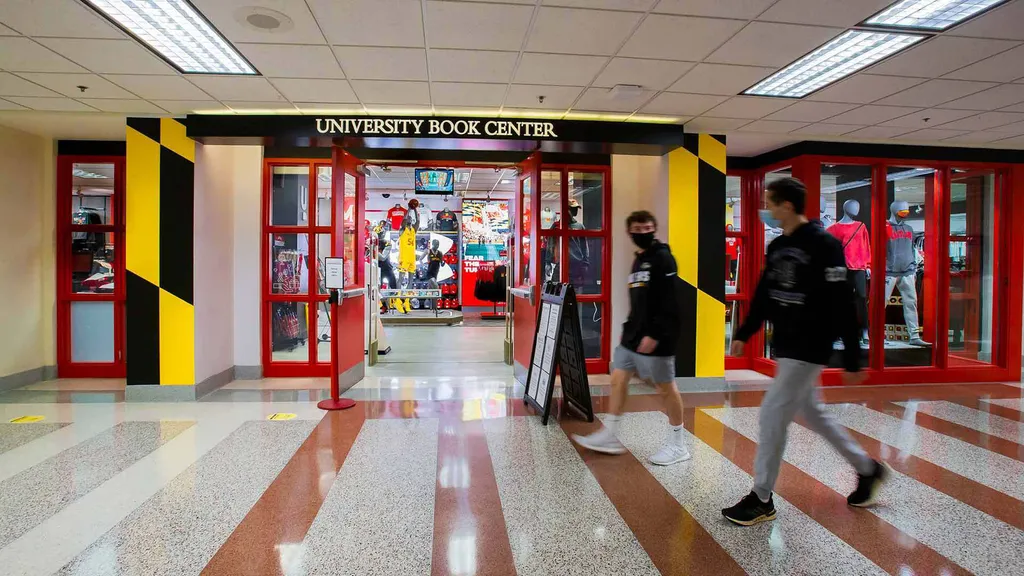- March 16, 2022
- By Karen Shih ’09
From career fairs to cultural festivals, early-morning coffee lines to late-night bowling and billiards, the Adele H. Stamp Student Union is the center of campus life at the University of Maryland. And somebody has to drizzle the caramel on the Starbucks macchiato or sanitize the bowling shoes.
Nearly a third of the campus population streams through its doors each day to buy books, grab a burger or attend a student group meeting, all under the omnipresent eye of Director Marsha Guenzler-Stevens, who has worked at the student union since 1987.
“People gather here for celebrations and through challenging times,” she said. “I think it’s critically important the students can bring their whole selves here and find that sense of home and community.”
Guenzler-Stevens and Associate Director of Operations Nicole Miskimon, who oversee 90 full-time and 500 student employees at the Stamp, talked to Maryland Today about the day-to-day hustle and bustle, the challenges of COVID and the thrill of having people back in the building.
Guenzler-Stevens: I get here around 7 a.m. on school days, when the building opens, and Dining Services workers are starting to sell breakfast. Around 8:30 is when you get the coffee rush—you can really see the rhythm of classes when the line is the longest. Our lunch crowd is the biggest of the day, from 11 to 2. Around 6 or 7 p.m. we get a lot of student groups. Last night when I left, there were two groups in the Prince George’s Room and the Atrium, both dancing. There was a SEE event in the Grand Ballroom, a movie playing at Hoff Theater and other student groups meeting on the second floor. Weekends can go pretty late with social activities until we close at 2 a.m.
Miskimon: Our building managers and student employees at the information desk, event and guest services—they’re the ones who do all the hands-on work of unlocking doors and making sure rooms are being set up for events. Students are the reason we are here, and they also do the work to keep us going, especially during the evenings and weekends.
They’ve been incredibly resilient and patient as their responsibilities have shifted these last couple of years. They’ve volunteered to help with line management when COVID-19 testing has gotten busy, helped the University Health Center hand out at-home test kits and are managing mask storage and distribution. Though they’re not always treated the kindest when encouraging folks to follow campus guidelines, they continue to support the campus and Stamp to keep this as a safe place for our community to gather.

Guenzler-Stevens: During COVID, there weren’t admissions tours, so when families would visit, our students would talk about their own lived experiences. I remember Kevin, one of our student managers, who just got this amazing scholarship to dental school, telling them about being a science student and drawing detailed directions on one of the campus maps.
COVID also affected our food vendors. When we had fewer people and food sales were down, we chose to forgive rent. We said, “We want you to pay your labor and stay open as many hours as you can, so that a kid who’s lonely in a residence hall or a colleague who needs to work on campus can come get lunch or dinner.”
Miskimon: Marsha and I are often in meetings, managing operations and emergencies—there have been more outages and detours because of the immense amount of construction around the building—but we do building walkthroughs several times a day. It’s important to make sure events are going smoothly and see what we can do better. It’s fun to see all the different things going on—I just got a calendar pop-up about a Women’s History Month recital downstairs, which I can go watch as I eat my lunch.
Guenzler-Stevens: We love our all-hands-on-deck events, like Maryland Day, Terp Thon or Homecoming—there’s a sense of everyone joining in and creating shared memories. We even brought in bumper cars one year! Everyone takes volunteer shifts. This year, it was a little after 11 p.m. at the All Niter, where students were dancing, playing bingo, doing Build-a-Bear and all types of arts and crafts. This young woman came out of the disco and said to me, “I’m a senior and I couldn’t get any of my friends to come with me, but I’ve been in there dancing and it’s the first time I’ve felt joy in two years.”
Stamp is home to so many student groups, and it’s a space for folks whose identities are really important to them. When we finished redoing the Student Involvement Suite, I was walking down the stairs with the engineer who did the project with us from Facilities Management. A kid behind us sees the space and goes, ‘Wow, that makes you want to get involved!’ It was great that he could hear that. There’s so many ways this place creates possibilities.
This is part of a monthly series that looks behind the scenes at “what it takes” to keep the University of Maryland humming and create a vibrant campus experience. Got an idea for a future installment? Email kshih@umd.edu.
Stamp by the Numbers
- 300,000 square feet
- 10 dining options
- 800+ clubs and organizations using the Student Involvement Suite
- 8 bowling lanes and 10 billiards tables in Terp Zone
Topics
Campus & Community